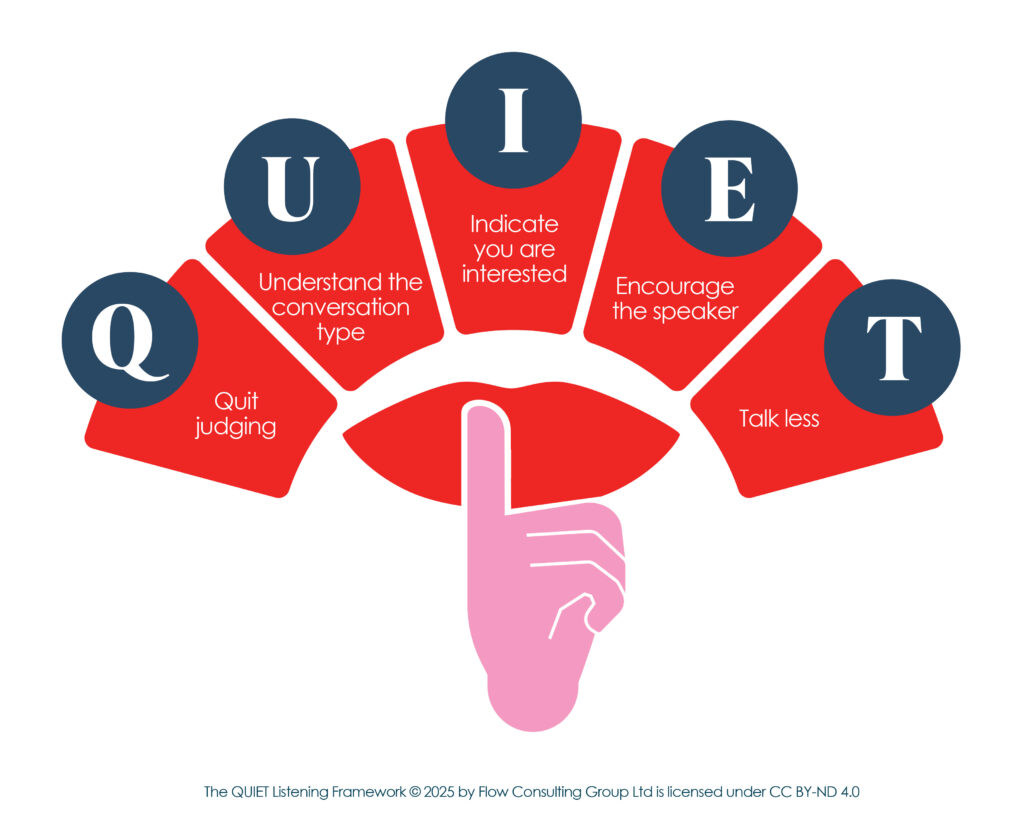From our first breath, we’re biologically wired to make noise to get noticed and survive. That same instinct carries into the workplace, where speaking first and loudest often feels like the playbook to being seen and succeeding.
But there is another way. The QUIET Listening Framework can help us move into meaningful dialogue that actually achieves the results we’re aspiring for.
Below, we’ll introduce you to the QUIET mnemonic and explain how to use it. But first, it’s important to understand why dialogue is so important.
The moment dialogue deteriorates, so does the possibility of change
Most meetings spend plenty of time in debate and discussion, but far less in genuine dialogue:
- Debate is about defending a fixed position and persuading others. If we’re doing any listening at all, it’s ‘listening to win.’ This is the type of listening that means others are wrong.
- Discussion allows for different viewpoints, yet usually ends in compromise rather than a real shift.
- Dialogue, by contrast, begins with openness and curiosity. It aims to understand others fully and co-create new possibilities.
Reputational instinct, time constraints, high stakes and overload all conspire to squeeze out genuine dialogue. We are creating dialogue-free workplaces.
Why listening to learn is so rare
When we think about what has driven our personal success, we might believe that it comes down to our instincts and opinions, our own confidence in ‘what matters most’. That we have a track record in sharing opinions that were ‘right.’ Genuine learning is often secondary to defending our perspectives. In addition, changing your mind is a sign of weakness, isn’t it?
But in a fast-changing world, what matters just as much is the ability to rethink, unlearn, and adapt. True ‘smartness’ lies not in being right, but in being willing to change our minds in pursuit of better outcomes.
“The rate at which you learn and progress in the world depends on how willing you are to weigh the merit of new ideas even if you don’t instinctively like them. Perhaps especially if you don’t like them”
Ray Dalio in Principles
This means questioning our assumptions, asking how we might be wrong, and seeking out perspectives that challenge us. Progress comes from humility, curiosity, and the courage to revise our views.
QUIET is the space for conversations that change perspectives
Don’t just be silent because you want to appear polite. Use the QUIET Listening Framework presented below to gather new insights about a problem or opportunity and get the results you want faster.

The QUIET Listening Framework’ © 2025 by Flow Consulting Group Ltd is licensed under CC BY-ND 4.0.
Quit judging
Our default position when we are listening is to think about whether we agree or disagree with what is being said. Record producer Rick Rubin’s sharp perspective is that “listening is suspending disbelief.” Replace judgment with curiosity. Stay open-minded to the points being made.
Understand the conversation type
Is this a conversation to improve understanding? To generate ideas? To problem solve? To make decisions and formulate plans? It’s likely a combination of the above. Conversations go south when you each have different expectations of what’s needed, so ensure you’re in sync with each other.
Indicate you are interested
In a busy world with constant distractions, time is the most valuable thing you can give people. The more you demonstrate that you are fully invested in what the other person is saying, the more likely they are to speak up and share their own insights.
Nodding, giving short acknowledgments, showing empathy and maintaining an open, engaged posture are all ways to indicate you are interested in learning.
Encourage the speaker
We all think much faster than we can talk (900 words per minute vs. 125 words per minute). This means that we often struggle to express our opinions clearly. Help the speaker say what they mean by using phrases such as:
‘Can you tell me a bit more about that?’
‘Go on’
‘I noticed earlier, you said…’
Talk less
This final principle might seem too obvious to mention. But in a world where we mistakenly think that effective communication is just about how well we speak, it’s helpful to understand that the person who asks the questions and listens more is the person who controls the conversation.
The less we talk, the more we listen to learn. The more we learn, the faster we reach our goals.
Catalytic Conversations are a force for connection
Our ability to achieve anything of significance depends upon the quality of our relationships. And the quality of our relationships depends upon the quality of our conversations.
We need bigger workplace conversations more than ever. To listen better. To change our perspectives together. When we practice being QUIET in our conversations, we aren’t just learning. We’re building connections with others at the same time.
High-value conversations at work are under pressure and first-job employees are entering the workplace with less conversational skill than previous generations.
To close the gap, HRZone and Flow have created the Catalytic Conversations Toolkit. The toolkit’s goal is to enable you to have conversations that bring you closer to your colleagues and, in turn, closer to accelerating positive change at work. It will equip you to have six different types of tough conversations.
If your natural tendency is to turn away from a bigger conversation, it can help you find the confidence to prepare for a conversation you’d like to have.







